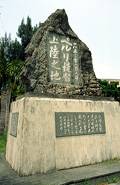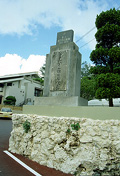In the start of the 19th century the United States began to consider Japan as a desirable port of call for ships operating in the North Pacific and trading ships going to and from China. In 1846 the US dispatched Commodore Biddle to present demands for opening of Japan but he was turned away by the Tokugawa Shogunate.
 The subsequent group dispatched by the US for negotiations with Japan stopped in the Ryukyus before heading to Japan. This time Commodore Perry headed the delegation. The Americans, knowing that the Ryukyu Kingdom was under the control of the Japanese, were thinking of occupying the Ryukyus, should negotiations fail with the Japanese on the mainland. In May 1853 Perry' fleet appeared in the Ryukyus seeking a treaty of commerce with the Ryukyu Kingdom. While these demands were refused, Perry did succeed in overcoming resistance to a visit to the royal court and he was able to gain admittance to Shurijo Castle.
The subsequent group dispatched by the US for negotiations with Japan stopped in the Ryukyus before heading to Japan. This time Commodore Perry headed the delegation. The Americans, knowing that the Ryukyu Kingdom was under the control of the Japanese, were thinking of occupying the Ryukyus, should negotiations fail with the Japanese on the mainland. In May 1853 Perry' fleet appeared in the Ryukyus seeking a treaty of commerce with the Ryukyu Kingdom. While these demands were refused, Perry did succeed in overcoming resistance to a visit to the royal court and he was able to gain admittance to Shurijo Castle.
In June the arrival of Perry's fleet in Uraga on the Japanese mainland resounded throughout Japan. Perry strongly demanded the opening of the country from seclusion and was refused but returned again the following year in March and was able to conclude the Treaty of Kanagawa by a show of strength. In this way the long national seclusion policies of Japan came to an end.
In June of 1854 Commodore Perry again visited the islands and forced the royal court to agree to the "Treaty of Peace and Amity between the Kingdom of the Ryukyus and the United States." The treaty contained provisions prescribing hospitality toward Americans, provisioning of fuel supplies and water, rescue and protection for shipwrecked American sailors, maintenance of the American cemetery, and piloting services.
The Tokugawa Shogunate collapsed under the pressure to open the country from the American and European countries and the modernization of Japan was begun. At the same time this new age became a surging wave in the Ryukyus.

Monument to Commodore Matthew C. Perry's Landfall in the Ryukyus
